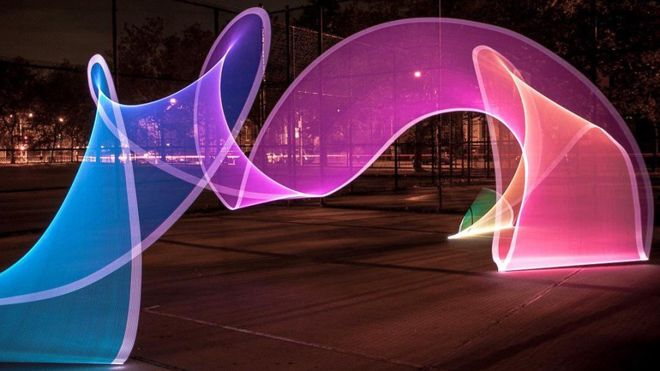No Mess Light Painting Explained
Light painting has been around for almost 130 years and doesn’t require any of the normal clean up from traditional painting. This art form has begun to resurface as the digital age becomes more popular. A new product, the Pixelstick , is a programmable LED “paintbrush” designed specially for this process. It creates simple single colour lines, complex rainbow coloured graphics, or photo-realistic faces and objects. LED lights lead the way in making light painting easy, versatile and precise.
What is it?
Let us back up for a minute to understand what light painting means across the ages. Ultimately it has revolved around using a source of light to create lines of an image while taking a long exposure shot with a camera. This involves a lot of trial and error as the light is manipulated to create the intended impact. As it applies to our current world, we have replaced the bulb, match, flashlight, or sparkler with our tiny light emitting diodes (LED) technology. We cover the operation and potential of the LED Pixelstick below.
The Art Explained
Light painting is accomplished in one of two ways. Primarily an artist uses a hand-held light source to draw an image in the air while a photographer co-part captures the scene. This is the most common method. The second and alternative way melds artist and photographer. The creator moves the camera instead to generate an abstract image. This requires a steady hand for the long exposure shot making this technique more difficult. In either method the night sky is often used as the canvas.
photographer co-part captures the scene. This is the most common method. The second and alternative way melds artist and photographer. The creator moves the camera instead to generate an abstract image. This requires a steady hand for the long exposure shot making this technique more difficult. In either method the night sky is often used as the canvas.
The LED Technology
The Pixelstick is a linear bar of 200 RGB LEDs. The stick has a SD card slot to upload a bitmap image file (BMP) for expression. Using bitmaps, the programming allows the user to create very fine detail since jumping activation of the LEDs is facilitated. This is much like pixels on a screen. However, the ‘screen’ becomes non-existent as the black aluminum casing and the operator disappear into the background. The small size and programmable nature of LEDs allows the freedom to change spatial location and colour with little to no restriction. This opens up the endless possibilities of the Pixelstick. Add in the potential of creating a video of light, and you can have hours of exploration at hand!
The Light Painting ‘effect’ on you
That’s exactly it! The effect it has on the subject. Maybe the effect is on you if you are striking a pose. Other times it is on an old abandoned firetruck in a field (see image included). The artist decides what to highlight. Their intent may be to create suspense, excitement or focus. This is where we find the theoretical simplicity of light painting. The familiar item, person or area is recreated. The artist creates interest for an item that may not have warranted a second glace. They reveal beauty in a moment of pause. Whatever the effect, it may be the light in front of the camera that decides the beauty, rather than the eye of the beholder.






0 Comments